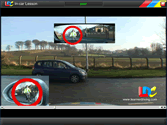

If you’re clicking at everything you see as a 'potential' hazard, or simply repeating your clicks in the hope you'll catch a hazard you may have missed you can get disqualified from that clip. It is good practice to click when you would take action, and again a second or two later, to ensure your click is within the scoring window, this will hopefully ensure you get some marks, even if your immediate click is slightly premature.Īs mentioned above a click represents you taking action against a hazard. In such scenarios you need to keep your eye on the pedestrian to ensure you’re ready to react in case they do turn into a developing hazard. The pedestrian walking their dog may continue along the pavement with no intention of ever crossing the road meaning you have hit the breaks or slowed down (as represented by your click) for no real reason.


So how is it possible to click ‘too early’? When you click during the hazard perception test you are registering the need to take action in order to avoid this hazard developing into an accident, such as beginning to slow down for a pedestrian who is about to cross the road. It is really important to remember that a hazard, in the hazard perception test, is something which will cause you to take action in the form of changing your speed or direction. Use a stopwatch to ensure you can get through 50 questions in the time allotted.Are you practising for your Hazard Perception test but keep getting told you're clicking the hazard too soon? You are told exactly where you have gone wrong if you answer a question incorrectly.

This allows you to detect your weaknesses and make improvements without having the upset of failing the test, or the expense of booking another one.
#Dvla hazard perception test series
uk has a series of tests where you can see what type of pass mark you’ll receive if you went into an exam room at this exact moment. If you read and study the Highway Code, Know Your Traffic Signs and Driving - The Essential Skills, you will be equipped with all the knowledge you could be tested on in the exam. Read the materials the tests are based on. This allows you to clear your head and prepare for the next challenge. You are allowed to have a little breather in between the multiple-choice questions and the hazard perception. It’s worth trying to allocate a little time towards the end to check for any silly mistakes which could end up being the deciding factor between a pass and a fail. In the multiple-choice section only, you can go back and amend your answers if you need to. This helps prevent you from becoming stressed, it’s a good form of time management, and answering other questions may help to jog your memory. Given the fact that there is a bit of time pressure associated with the multiple-choice section, it is worthwhile making the most of a feature that allows you to skip a question and answer it once you have completed everything else. Not sure about a question? Come back to it at the end. However, it is possible that you can misunderstand what is being asked and provide the wrong answer because of it. As we mentioned, there are no trick questions.
#Dvla hazard perception test how to
5 How to boost your theory test pass mark


 0 kommentar(er)
0 kommentar(er)
